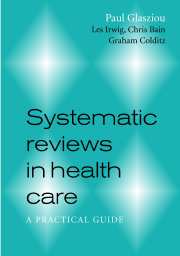Book contents
- Frontmatter
- Contents
- Acknowledgements
- Introduction
- Part 1 General methods
- 1 The question
- 2 Finding relevant studies
- 3 Appraising and selecting studies
- 4 Summarizing and synthesizing the studies
- 5 Applicability: returning to the question
- Part 2 Question-specific methods
- Appendixes
- Glossary
- Acronyms and abbreviations
- References
- Index
5 - Applicability: returning to the question
Published online by Cambridge University Press: 01 September 2009
- Frontmatter
- Contents
- Acknowledgements
- Introduction
- Part 1 General methods
- 1 The question
- 2 Finding relevant studies
- 3 Appraising and selecting studies
- 4 Summarizing and synthesizing the studies
- 5 Applicability: returning to the question
- Part 2 Question-specific methods
- Appendixes
- Glossary
- Acronyms and abbreviations
- References
- Index
Summary
Having completed the systematic components of the review, it is important for the reviewer to return to the original question, and assess how well it is answered by the current evidence.
How important are study design flaws in the interpretation of the overall results?
Is publication bias an important issue?
If further research is needed, then specific suggestions should be made about the necessary design features rather than a simple call for more data.
To apply the results of systematic review requires more than the inclusion/exclusion criteria of the studies involved. Rather, it must be considered how a particular individual or group would differ from the study population. This clearly differs for each of the question types. Below we give a brief summary of the issues that might be considered when applying the results of intervention studies.
For questions of intervention or treatment, the issue is how the effect sizes might differ in different individuals. We suggest examining the predictors of individual response and risk, and how the risks and benefits balance varies with these. The following five-step process may be used when interpreting reviews.
What are the beneficial and harmful effects? Trials and meta-analysis should consider all patient-relevant endpoints potentially influenced by the treatment, including adverse effects. For example, antiar-rhythmic drugs have proarrhythmic effects; anticoagulants increase the risk of bleeding. Particularly for low-risk groups, such adverse effects may be crucial. It is helpful to begin the meta-analysis by tabulating all possible positive and negative effects of the intervention; data may or may not be available.
[…]
- Type
- Chapter
- Information
- Systematic Reviews in Health CareA Practical Guide, pp. 45 - 50Publisher: Cambridge University PressPrint publication year: 2001



